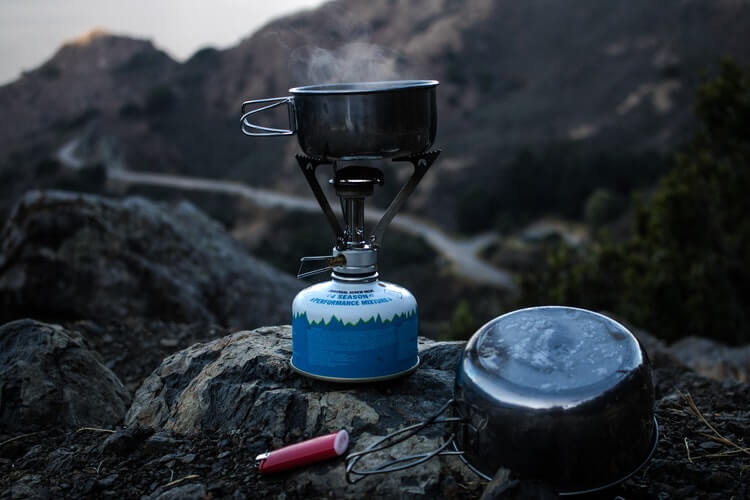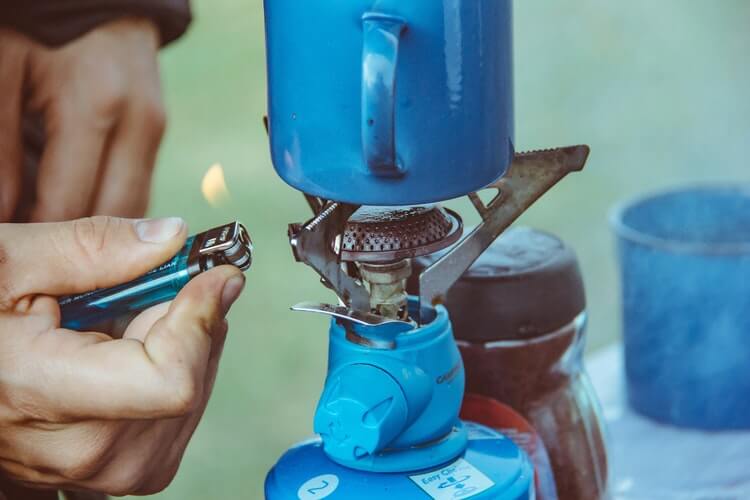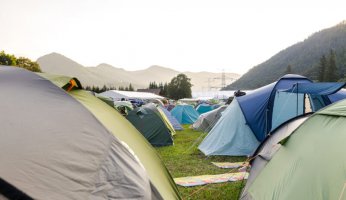The Different Types of Camp Stoves
 The Different Types of Camp Stoves
gearweare.net
The Different Types of Camp Stoves
gearweare.net
Spending the night in the outdoors doesn’t mean that you have to eat any differently than you would at home. With the right camp stove, along with knowledge on how to use that stove, you should be able to whip up favorite meal miles from the nearest kitchen. This article breaks down the different type of camping stoves that are currently available so that you can pick the one that most adequately fits your needs.
Table of Contents
Car Camping vs. Backpacking Stoves
The first thing that anyone looking to buy a camp stove needs to think about is the type of camping environment where they will primarily be using that stove. The two types of environments can be broadly broken down into car camping and backpacking.
Car Camping: As the name suggests, when car camping a vehicle is utilized to get to the area where the tents will be pitched, the campfire stoked, and meals cooked under open skis. This means that camping supplies will be walked no more than 100 feet from the car. In these conditions, weight and bulkiness of gear do not have to be accounted for – as long as something fits in the car it can be brought along. For this reason, car camping stoves can be quite large and heavy.
Backpacking: When backpacking, everything that is needed to make camp is hiked in the wilderness utilizing one’s own strength. The distance you go each day while backpacking can vary, but typically it is significantly more than a few miles. In this situation minimizing weight is of the utmost importance, so stoves used while backpacking is designed to be as small and light as possible.
It should be noted that stoves designed for backpacking can be used for car camping, but the reverse is not true. This is because the size and weight don’t matter as much when camping out of one’s car but are integral to account for when venturing into the backcountry. Those buying their first stove may want to invest in a smaller one so that they can use it in more diverse situations.
Those who know they will never be taking their stove backpacking should forget about versatility though and just get a bigger stove though. That’s because larger stoves tend to be more reliable, often cook food faster, and can accommodate making dinner for more than one or two people.
Car Camping Stoves
Compact Double Burner Stove: This is the classic car camping stove. No joke, start looking around any given campsite and you are likely to notice that most people are using this stove. That’s because these stoves are compact and easy to travel with, cook food quickly with a design that blocks wind, and have two burners, which allows for multitasking and making more complicated meals. They typically run on propane, which is easy and cheap to get.
Tabletop Single Burner Stove: These stoves just have one burning, which makes them a good choice for those who like to car camp alone. However, they often run on butane, which can be hard to find. For this reason, you may be better off using a backpacking stove instead of one of these.
Freestanding Stoves: These stoves can be found with a variety of different burner number, from one to as many as four. Furthermore, they have their own legs, so they can be set up anywhere and don’t need to take up valuable table space. They come in many different styles, some better than others, so make sure you do your research before purchasing a freestanding stove. Most use large, propane tanks for power.
Backpacking Stoves
Canister Stoves: These are the quintessential stove for backpacking. Most are extremely light, and they utilize isobutane for fuel, which is very easy to buy. They come in a few different styles. The smallest type involves just a small burner and a place to sit a pot that is skewed directly into the fuel canister. Larger versions also have a stand that makes it easier to stabilize the stove. Finally, integrated canister stoves have been becoming more popular. These include a cooking vessel that can be directly attached to the stove. These boil water very quickly, and provide great wind protection, but are heavier and can be quite expensive.
Liquid Fuel Stoves: These stoves are preferred by some backpackers because they quite fuel efficient and can run on many fuel types. The fuels that run these stoves include gas, kerosene, and diesel, however not all liquid fuel stoves can take every type of liquid fuel, so make sure to double check before trying something new. These stoves are heavy and require many pieces, which is their primary downside.
Alcohol Stoves: These stoves can be purchased or made in a DIY fashion from an aluminum can. To use them simply add a small amount of denatured alcohol. The upside of these stoves is their small size, lightweight nature, and durability. The downside is their inefficiency and the impossibility of controlling the flame.
Wood-Burning Stoves: There are also stoves on the market that use wood inside a small metal barrier to heat and cook food. Since those able to collect wood will not need to bring any fuel to go with this stove, these stoves can be very lightweight. However, the flames on these stoves can be controlled, and they can’t be used if there is a fire ban or no wood can be found.
Cooking By Fire
Those wanting to nix using a camp stove altogether can utilize a campfire instead. Although there is an allure to this method, make sure to really think about what it will entail before leaving the camp stove behind. Cooking over the fire requires the fire to get hot enough, which for some foods can take hours. Also, if this is your decided method, make sure to figure out how the food will be cooked before packing. Will you use skewers? Will there be a grate at your campsite? Should you bring a grate? Will you simply wrap your food in tinfoil or do you own a Dutch oven? These are the types of questions those thinking about cooking over fire should be asking themselves since the answers to these questions will make for completely different camp cooking experiences.
It should also be noted that with wildfires becoming more of an issue, fire bans are becoming more frequent. Make sure to double check the current fire safety protocols where you will be camping before deciding that you will be cooking your meals using the fire pit.













